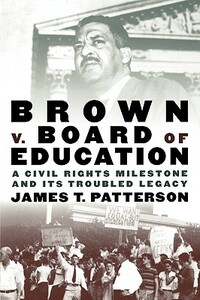Take a photo of a barcode or cover
7 reviews for:
Brown V. Board of Education: A Civil Rights Milestone and Its Troubled Legacy
James T. Patterson
7 reviews for:
Brown V. Board of Education: A Civil Rights Milestone and Its Troubled Legacy
James T. Patterson
Good review of this history; thought provoking questions at the end.
challenging
informative
slow-paced
This is a very thorough overview of the history and repercussions of one of the most well known Supreme Court cases of all time. I think that, if one is not directly impacted by the rulings, it is easy to believe that the decision was unambiguously embraced by anyone who was not an out-and-out racist. While I knew to some extent that this was not true, and that there are and always have been questions about the effectiveness and desirability of enforced desegregation in schools, this book gave me a much better grounded view of opinions on all sides for the 50 years following Brown. In a nutshell, the two competing values in this discussion are equality and community. The search for equal opportunity and equal treatment drives integration analyses, and the values of community, of not being racially isolated, of being taught by Black teachers in a school with Black administrators as models drives the (non-racist) segregation analyses. I mean, it kind of stands to reason, right, that being one of maybe 10 or 15 Black kids in an otherwise all-white school isn't going to suddenly make a positive difference to the Black kids.
The thing is, this is a really really hard question. Thurgood Marshall always believed that the first step toward equality is school integration. And in some ways, you can't help but agree with him, at least in principle. But the history of the Supreme Court decisions on educational integration is just fraught with missteps. Even so, one of the takeaways from this book is that, whether coincidental or causal, Brown heralded an era of Black activism and empowerment.
The only reason this isn't a 5-star read is that it is densely packed with data. It is a worthy read, but not one that will keep you on the edge of your seat.
The thing is, this is a really really hard question. Thurgood Marshall always believed that the first step toward equality is school integration. And in some ways, you can't help but agree with him, at least in principle. But the history of the Supreme Court decisions on educational integration is just fraught with missteps. Even so, one of the takeaways from this book is that, whether coincidental or causal, Brown heralded an era of Black activism and empowerment.
The only reason this isn't a 5-star read is that it is densely packed with data. It is a worthy read, but not one that will keep you on the edge of your seat.
informative
relaxing
fast-paced
It was very educational and a very good look at the Supreme Court and the law in regards to desegregation.
Patterson's book is a short, informative look at the Brown decision, one that sets it into the context of its times and examines its impact -- and limits -- over the half-century that followed. Though there are more detailed studies of the decision, Patterson's book is a fine starting point for anyone seeking an introduction to the subject.



